No, not the classic Bob Welch era Fleetwood Mac album, although that does contain one of my favorite songs of all time, “Hypnotized”. The mystery to me today is fencing master John McKee from Southern California who trained hundreds and hundreds of fencers over decades. For all the people he taught and all the times he was in the paper, it’s his nature and character that I can’t get a handle on.
Our subject, the fencing master of the long-lasting Cavaliers club, John McKee. I was fortunate to get a packet of scanned papers from Archive helper Kevin Murakoshi sometime back and have gone through them a number of times. Additionally, I’ve perused through various search results on Newspapers.com to pull up contemporaneous articles that can give some insight into all kinds of background detail. Where he taught, the names of his fencers, what they won, demonstrations given, all kinds of things come up. And some really sketch photos from scans gone bad. How can someone working for Newspapers.com not know how to use a scanner? There are some bad ones, let me tell you. An example is the photo at the top of the page. I did some editing and clean up to turn it into an artistic statement, or as near to one as I can approximate. Added to this source material is a transcript from an interview with McKee’s most successful fencer, Maxine Mitchell, who was coached by him during the first fifteen years of her long career and is pictured with McKee in that top photo. Maxine’s achievements during her years with McKee include her four-way tie for 3rd, fifth on indicators finish at the 1952 Olympic Games.
One of the papers sent by Kevin to me is titled “A History of the Cavaliers of California” and it is a fascinating document in a number of ways. The first thing that jumps out at me, because, let’s face it, it’s me… is this sentence: “I am glad that I kept such a detailed record in several thick scrapbooks such as press clippings, telegrams, notes, schedules and competitive results.”
Several. Thick. Scrapbooks.
Let me try to write that in the way I hear it in my head. “several thick scrapbooks… several thick scrapbooks… several thick scrapbooks…” repeating, over and over again, endlessly knocking against the interior walls of my poor brain. These are the things that keep me awake at night.
Where are they?
Knowing I can’t answer that question here and now, let’s move on. The History, as written by McKee, is long on story, short on the type of detail usually found in a history and also plays fast and loose with dates. That’s not to say it doesn’t start with a bang. John McKee’s first experience with fencing happened at age 12 after finding a foil in a store room in the house his family was renting in Mexico City. At the local YMCA he received lessons for a brief time with Lucien Gaudin, moonlighting or vacationing in Old Mexico after winning what is considered the first World Fencing Championships held in 1921.
Lucien Gaudin in a photo from 1928, the year he won gold in the individual foil and epee events at the Amsterdam Olympic Games. Gaudin began winning international events in 1905 and continued to win them for over two decades. While contemporaries like Aldo and Nedo Nadi turned professional, Gaudin remained an amateur. The large purse he collected for his victory over Aldo Nadi in the first of their high profile matchups was donated to charity. It’s worth noting that Gaudin was 36 years old to Nadi’s 22 years when the two met in that first match. When Nadi finally defeated Gaudin a couple of years later, on his third attempt, Gaudin was nearly 40. Just sayin’. Gaudin committed suicide at age 47 when his business interests failed.
Say what now? How many fencers can boast of having Lucien Gaudin as their first coach? Not damn many. After what I’d like to call his “Summer With Gaudin”, McKee didn’t fence again until 1930 while living in Honduras. He would have been around 19 years old. After dating a young woman, he discovered her father was an Italian fencing master, one Luis Scaramuzza. I’ve been trying to track down information on him with no luck. My command of Spanish is limited to copying and pasting text into a Google Translate box and reading the results but online Honduran newspapers have yet to reveal to me any information about 1930s fencing masters. McKee spent two years working with Scaramuzza for two hours a day (presumably with a few holiday breaks) then began flying around the South American region to every competition he could find. Interestingly, he says he traveled to all these events because his father owned a small airline, TACA, that flew all over the region.
Now, his description of his father ‘owning’ an airline in South America sent me rabbit-holing around the internet to discover what I could about TACA airlines. First and foremost, it was not owned by anyone with the name of McKee but rather was founded by a New Zealander named Lowell Yerex. Fascinating story. That’s not to say McKee’s father wasn’t an early employee. TACA was founded in 1931 in Honduras and had several planes and pilots working the region mostly delivering mail and freight, although Yerex had dreams of creating a commercial passenger airline. As McKee tells it, he traveled and competed in tournaments from 1932 to 1935. According to a chart he created and duly entered into his history, he entered 160 tournaments, winning 71 of them and taking 2nd or 3rd in 34 others. He states, “I had won 63% of the medals in all my events.” Either his math skills were poor or what he actually meant was “I had won medals at 63% of the events I entered.” But as I mentioned above, McKee’s history plays a bit loose with dates, and maybe facts, as evidenced by his final note on his competitive career. He says he won the Western Hemispheric Championships in sabre in 1962 and 1972, an event he claims eventually became the “Pan American Olympic games”. In fact, the Pan American Games started in 1951, so a precursor win in ’62 and ’72 is either a typo, a poor remembrance or something entirely inaccurate. Immediately available history of the Pan American Games lists only one event as a near-precursor to the first actual games of 1951, that being a poorly-attended event held in Dallas, Texas in 1937 that has never been counted as an official event even though it was called the Pan American Games.
Where am I going with this? McKee was accepted as a quality coach and he clearly had training and dedication. But the truthiness of his record might not bear scrutiny. And he makes some fairly outrageous statements in news articles over the years too. We’ll get to that. Back to history.
McKee opened his first club as the Guardsmen in 1935 in Glendale, CA. Around 1940 McKee bought out another club with the Cavaliers name from one Joe Smole and McKee liked the new name so much he gave up Guardsmen. That coincided with a move from Glendale to Pasadena. Almost all of McKee’s clubs were housed at YMCA’s. He has a list of locations from 1935 to 1976 but these weren’t necessarily moves that shut down a previous location. He sometimes taught at more than one place and he also had student teachers and assistants who would take on the running of a program. The heyday of his program was between 1946 and 1965 when his membership was over 100 for that twenty year run, peaking at over 200 for five years in the mid-50s. By the time he wrote this history in 1984, his membership had held steady at around 20 fencers since 1970.
There isn’t much I can do about this scan from Newspapers.com. It is what it is. But the caption is what caught my attention in this article from 1953.
Maxine Mitchell, in an interview conducted by her friend Demi Huddleson, spoke of her time with McKee. Of his coaching, she said McKee taught a firm grip and a heavy hand. “Rough fencing,” is what Maxine called it. In her preparation for the 1952 Helsinki Olympics she spent a month in New York studying with Rene Pinchart at the New York Fencers Club where she learned finesse, something she never got from McKee. That was her first exposure to alternate styles of coaching but by no means her last. McKee kicked her out of the Cavaliers during a minor tiff in an attempt to show Maxine who was boss, thinking she would beg to be readmitted. Maxine never went back. Her final thoughts in the transcript on McKee aren’t terribly kind. I’ll quote from Demi’s shorthand notes. “Connived and cheated on little things. Had 3 successive wives. Lost fencers. Maxine was the only one left from the old timers.”
One of McKee’s early success stories was Moreene Fitz – and that does seem to be the correct spelling for her first name.
Of the “old timers” that Maxine mentioned, one of the top fencers from the early Guardsmen/Cavaliers was certainly Moreene Fitz. One article mentioned her taking second place to Helene Mayer at a six-person tournament held in San Francisco in April of 1939 and that her placement thus qualified her for the Olympics of 1940. That the 1940 Olympics were never held is a given but the notion that one tournament qualified her to those lost Games when I can find no record of her making a National finals seems a little offside. Once again, the lack of a contemporary magazine or newsletter posting results leaves me wondering how often Miss Fitz (later Mrs. Leggewie) was taking first prize in the Southern California regional events. Another short bio of her noted that she was a finalist at Nationals in 1941 through 1943. Without an influx of reference material that I don’t even know to exist, I can only speculate on the accuracy of that claim.
Here’s Moreene again from April of 1956 when she had been for five years the fencing coach at Pomona College. Here, she’s credited as a former Olympic Squad member (usually the top 24 fencers in any weapon), a PCC’s champion and a “contender” for the National title, whatever that means. If nothing else, we can see McKee’s influence in the Italian foil since his formative training was under the Italian Maestro Scaramuzza.
Another document from the packet from Kevin is titled, “About the Cavaliers”. There are several stories used to make a specific point to his students and, likely, some parents. Cavaliers was a “closed club”. If you were from another salle, you couldn’t show up and fence. If you were a Cavalier, you couldn’t go to another club and fence. If you did and he found out about it, you were out and dues were forfeit. He continues with, “We have been through the Courts on this a few times and we have always won!” For all the charts and graphs contained in the papers, there isn’t one charting the court cases filed against him to repay dues from forfeiture. I wish there was. To me, having fenced at lots of clubs as both member and guest, the notion of the Closed Club gets under my skin. I’ve certainly stepped into clubs where the reception was frosty – and I’m looking at you, Halberstadt circa 1982 – but I don’t think it ever occurred to me that a club would have turned me away altogether. He describes his logic with a couple of analogies. “Members of the RAMS football club do not go and play with the Oakland RAIDERS, Basketball pros on one team do not relax by visiting other pro teams. And so the members of one Salle do not go and visit members of another. When one does, we know almost immediately!” As a method of controlling the training regimen of your fencers, ok. Keeping them on task, working on specific drills, physical training, etc. If you’re prepping for a big tournament, that focus and intensity is required, no distractions, I get it. But the way it’s presented here smacks of the whole ‘botta secreta’ notion where the Master proclaims, “Only I have the gifts to make you great!” and that’s always rankled with me. True, I was tutored by coaches who preached the opposite, pushing me to get out there and learn from everyone, so the polar opposite of that is never going to sit right because of how I was raised up. Hey, look! A chart!
There’s a lot going on here. Locations, number of students, medals won, years active, all in one handy, hand-plotted graph. I think John would have loved Excel.
When I started looking into McKee’s history in preparation for writing this, I first looked through Newspapers.com to pull out articles from newspapers that could give me some insight. I pinged Andy Shaw of course, but he had surprisingly little. Of all the material he has amassed – if you haven’t visited Shreveport, LA for crawfish and jambalaya, go visit Andy’s Museum of American Fencing – and he has an enormous collection, he only has one picture of John McKee. That’s why I have a subscription to Newspapers.com. I found a good number of articles, ranging from 1937 to 1987, so fifty years worth of reading. (It’s less than 40 articles.) For some reason, I read the 1987 article first. Here’s the headline:
The headline of an article about McKee from the Los Angeles Times, circa November of 1987.
When I read that headline, I had to stop and think for a minute. No peers? That’s a pretty bold statement. However, rather than stop there and form a complete opinion from the single source, I read back through all the other articles to see how this notion tracked over time. The results don’t match with reality as I understand it. Starting in 1956, a news article about McKee states, “There are only 20 accredited fencing masters in America.” In 1958 and 1960, the number has dropped to 10. “One of 10 fencing masters in America and ranks second in that category.” I mean, I could go back and see who the ten fencing masters were that died between ’56 and ’58, except I recognize bullshit when I see it. Now, I can accept that newspaper columnists and reporters can take a quote from a subject and turn it into anything they like but both the articles in ’58 and ’60 have the same number; 10 fencing masters in the US. Where did that number come from if not McKee? Even dismissing the “ranks second in that category” as self-publicizing grandiosity, ten’s a small number. Especially in light of the notation in his own history, where McKee names the other fencing masters in Southern California during the 50’s & 60’s. He lists Ralph Faulkner, Jean Herrimans, Henri Uyttenhove, Joseph Vince and Aldo Nadi. Counting him, that makes for six just in SoCal alone. But the rest of the country has only four? It’s not even plausible. But wait! It’s gets better – or worse, depending on your outlook. In 1969, he was simply, “one of the nation’s top ten fencing masters”, but by 1985, it’s: “the United States once had as many as 10 fencing masters and he is disappointed to see the number dwindle”. This particular article has quite a few zingers. The “dwindle” quote is follow up with, “…one of only two masters in the United States. The other is George Santelli of New York.” That’s some dwindle. Twenty, then ten, and finally ‘just me & Santelli’. In surfing, they say, “Go big or go home.” McKee was living in Huntington Beach during this time so I can only guess he understood this notion, since the final quote from this 1985 article reads, “Here I am, 74 and overweight, and I can still compete with the best of them.”
From the 1987 LA Times article, two years after saying he could compete with the best of them.
The 1987 article starts this way: “John McKee isn’t fencing competitively anymore, but it doesn’t matter. There isn’t anyone in the United States good enough to challenge him, let alone beat him. And he’s 78 years old. “It’s like being the best in anything” said McKee of Huntington Beach, this country’s only master fencer, the equivalent of being ranked No.1 in any sport. “You have to beat everyone else to challenge the champion. Right now there’s no one like that in this country.”
Santelli passed away in 1985, so I guess that just leaves John McKee. The country’s only master fencer.
In writing all this and looking through the available material, any conclusions about McKee, who he was, what he was all about, remain amorphous. That he was dedicated to the sport of fencing is obvious. He was a tough, controlling task-master, and by no means the only fencing coach with those qualities. Heck, that stuff’s practically a job requirement. He promoted the sport endlessly. He produced champions and taught for more than fifty years. Mad props for all of that. But there’s this other side to his character that can’t be overlooked. Maxine Mitchell spoke of it as “conniving” and “cheating on little things”. I never met McKee and can’t therefore form an opinion based on personal interaction. And yet, I’m really clear that an overweight 74 year old can’t compete with the best fencers of the day. It’s errant nonsense. It reminds me of the story I’ve heard about that was often told by Dr. William O’Brien, how Hans Halberstadt defeated Daniel Magay and Tom Orley when they visited the Halberstadt club in 1957 when Hans was in his 70s, Dan was an Olympic Gold medalist and Tom a Junior World Champion. It’s pure fantasy.
The one photo Andy Shaw has in his collection. John McKee is on the far left congratulating a fencer. Maxine Mitchell is the woman 3rd from the right.
I’m left with a sense of bewilderment, unable to find correlation between the good qualities of John McKee’s ability and results with the obvious exaggeration of his status in the firmament of master fencers. I haven’t solved anything here, that’s certain. And he’s a subject I plan to revisit, if only to relay some pretty funny stories that he tells in his History document. Yet, as much as I like fencing stories, I prefer factual ones. Are John’s true? I really have no idea.


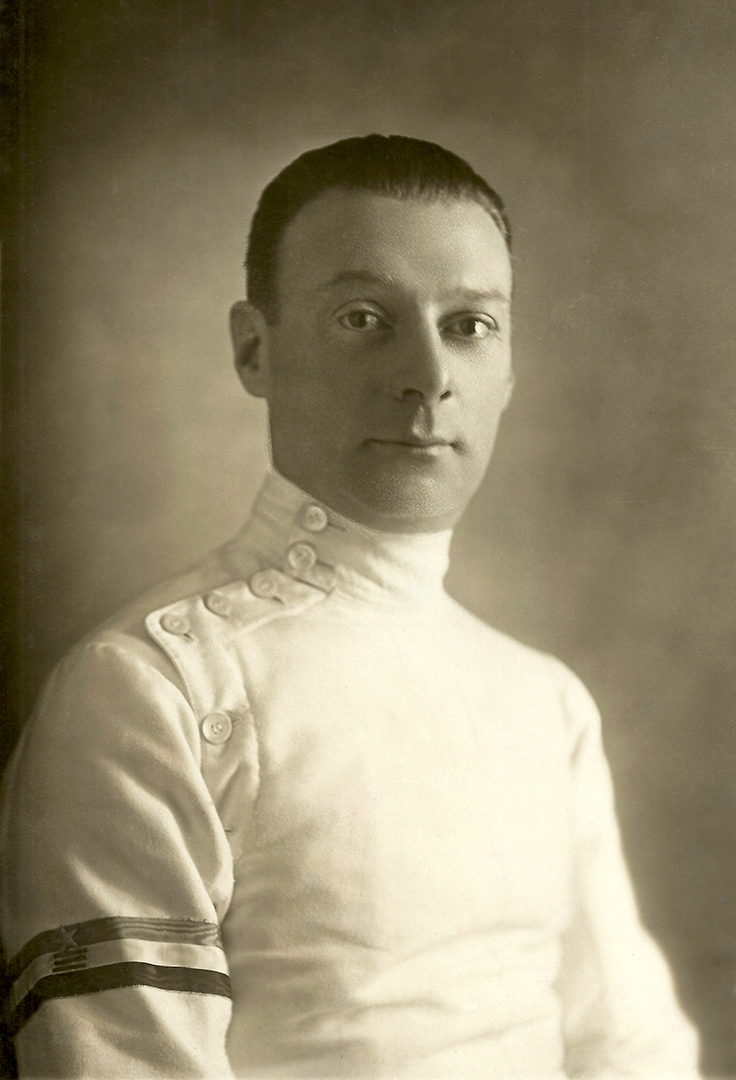

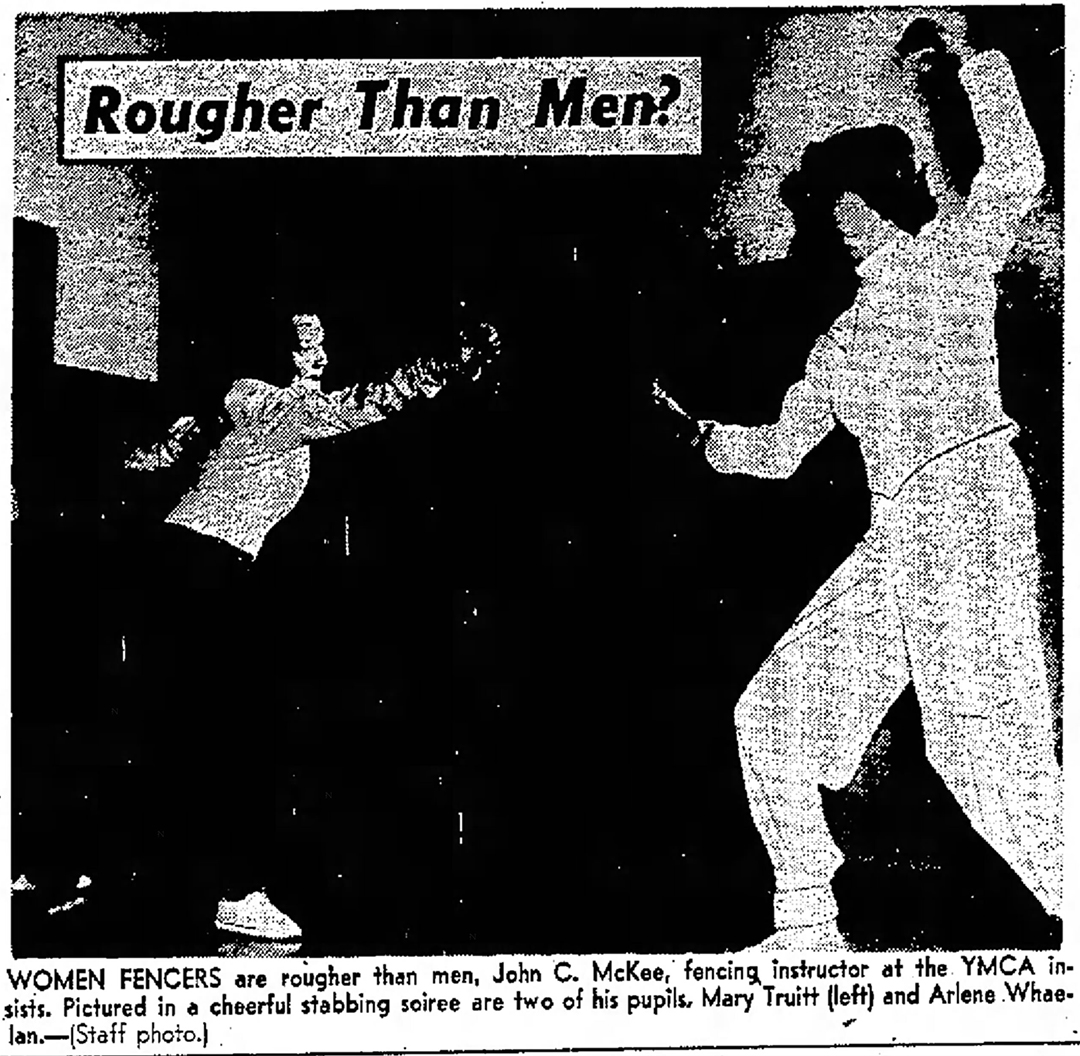
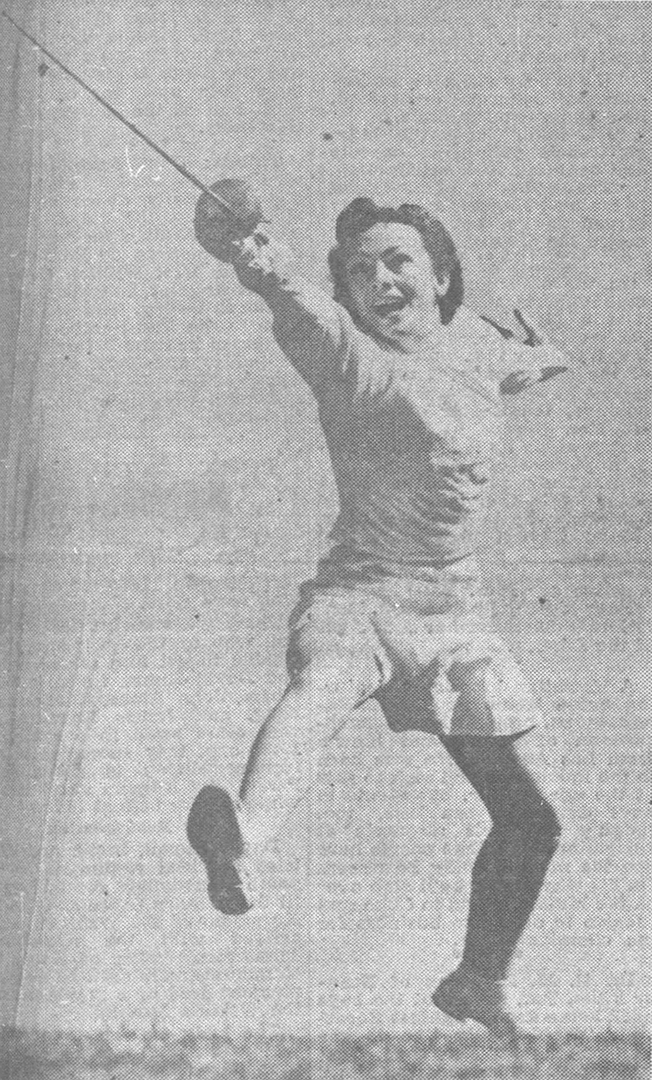
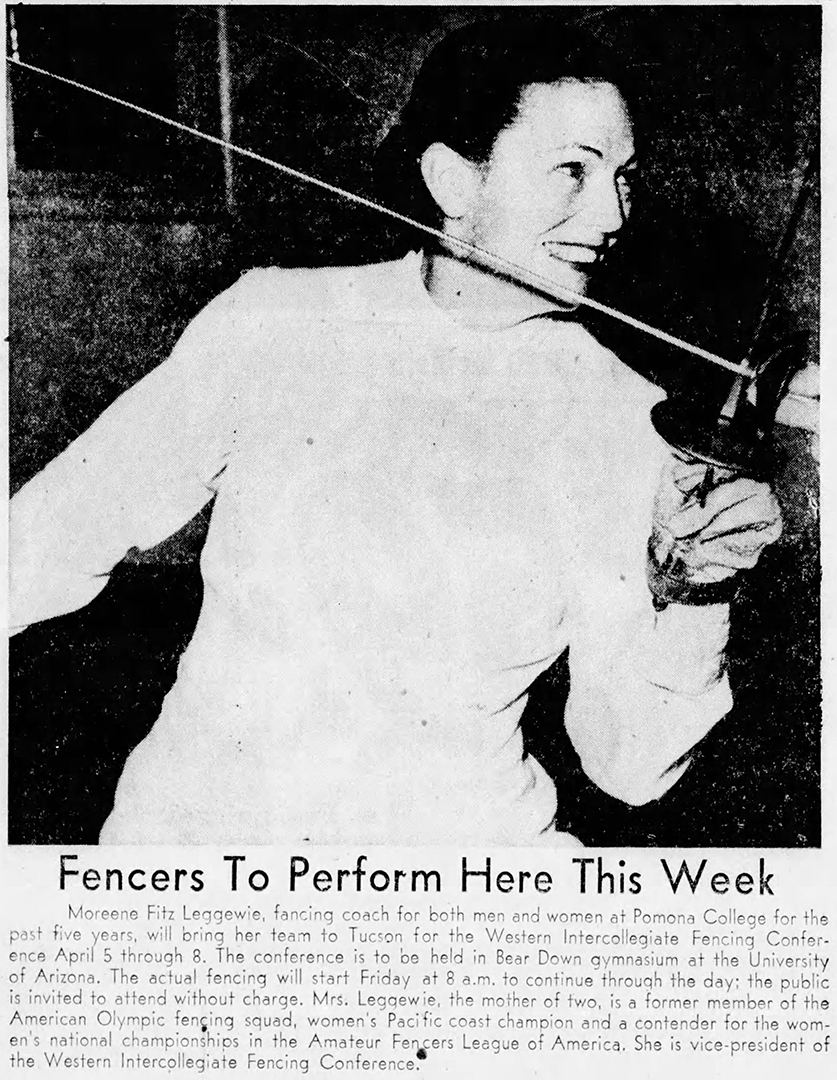
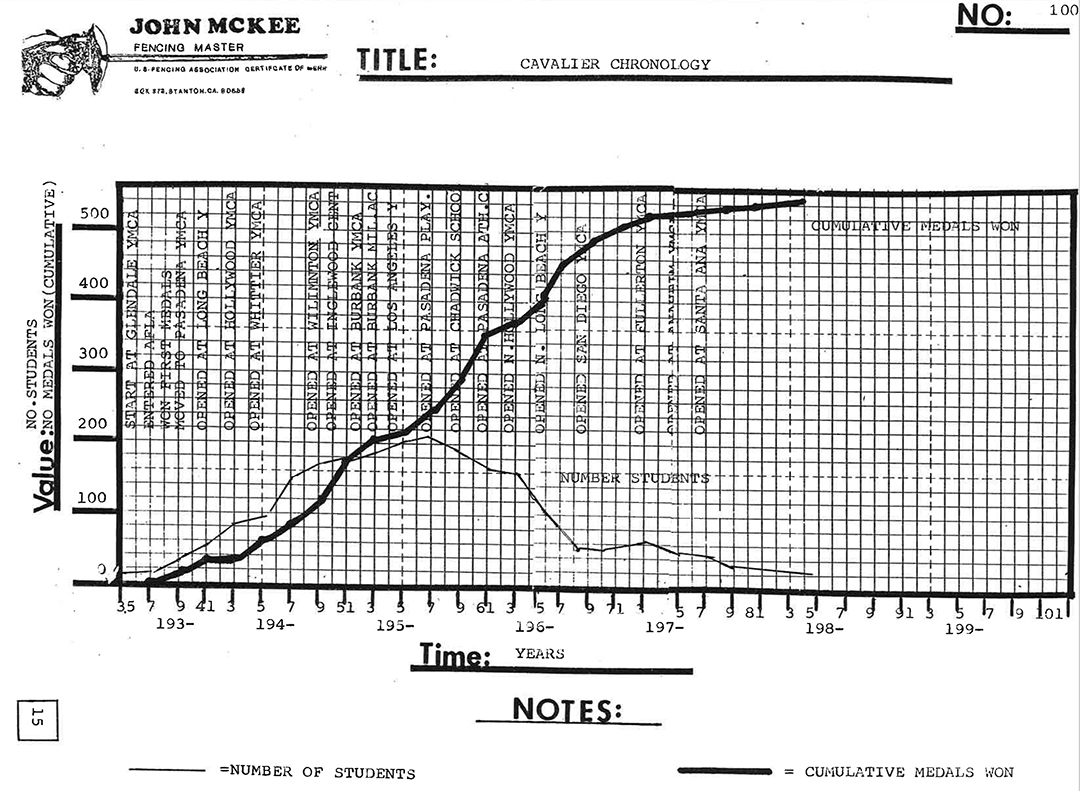

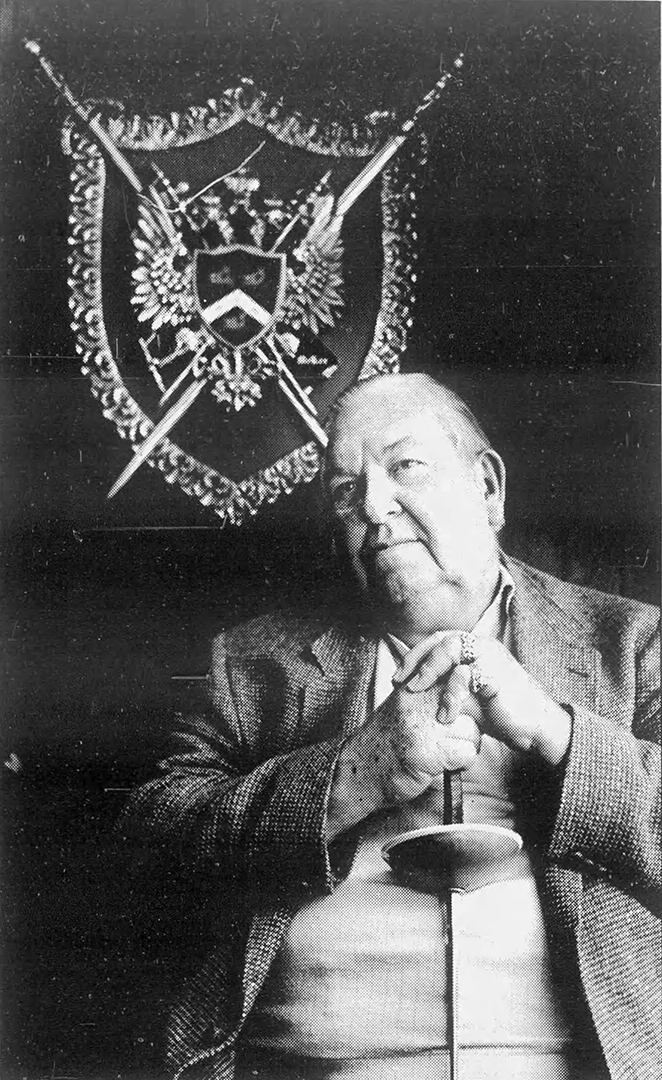
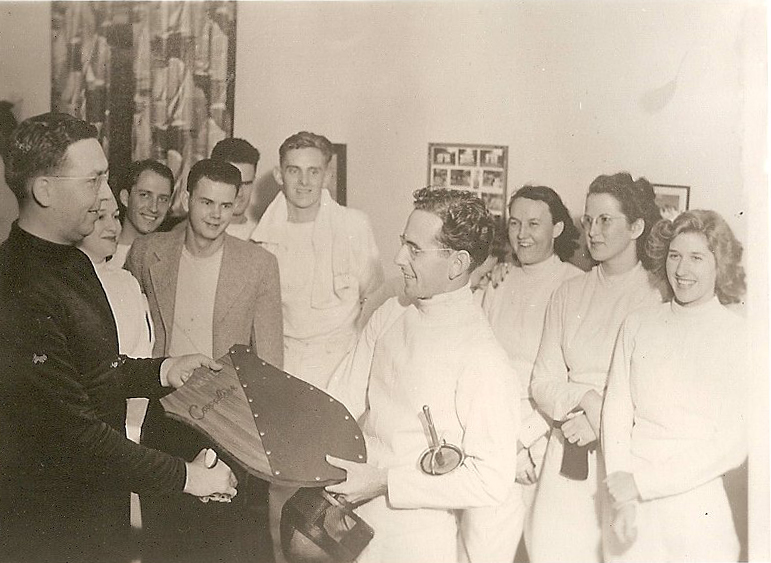
I just found this post on John McKee. I was one of his fencers in my teenage years Got to know him very well , fencing weekly both at Pasadena and Long Beach YMCA’s during the early 1960’s. Have great anecdotes and some fascinating background on this very complex man. I’m 75 now, would enjoy sharing some McKee lore with you. Email me if you’re interested. He was a fascinating character.